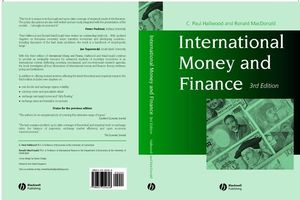|
Textbook
International Money and Finance, 3rd EditionISBN: 978-0-631-20462-6
Paperback
566 pages
September 2000, ©2000, Wiley-Blackwell
 This is a Print-on-Demand title. It will be printed specifically to fill your order. Please allow an additional 10-15 days delivery time. The book is not returnable.
|
||||||
List of Tables.
Preface to the Third Edition.
Part I: Introduction:.
Part II: Some Basic Concepts in International Finance:.
The exchange rate.
The balance of payments accounts.
Purchasing power parity.
Floating exchange rates: prospect and retrospect.
Exchange rate volatility.
Part III: Spot and Forward Exchange Rates: Some More Basic Ideas:.
The elasticities view of the exchange rate.
The forward exchange rate, arbitrage and pure speculation.
Covered interest parity - empirical evidence.
Uncovered interest parity - empirical evidence.
Real interest rate parity - empirical evidence.
Part IV: Income and the Balance of Payments:.
The foreign trade multiplier.
The equilibrium real exchange rate.
An early view of economic management.
The assignment problem.
The absorption approach.
Intertemporal utility maximization and the current account.
Twin deficits.
Foreign repercussions with no capital mobility.
Part V: Macroeconomics in an Open Economy: The Mundell-Fleming Model and Some Extensions:.
The "base-line" Mundell-Fleming model.
The large country case.
Insulation and the MF model.
Imperfect capital mobility and the MF model.
Regressive expectations and monetary-fiscal policy.
The J curve and regressive expectations.
Wealth effects.
Aggregate supply, the real balance effect and the exchange rate in the MF model.
Summary and conclusions.
Part VI: International Policy Coordination:.
The two-country Mundell-Fleming model and macroeconomic interdependence.
The potential gains from policy coordination.
Dynamic games and the sustainability and reputation credibility of international cooperation.
Some evidence on the potential benefits of coordination.
Potential impediments to policy coordination and the appropriate form of such coordination.
Part VII: Purchasing Power Parity: Theory and Evidence:.
The absolute and relative purchasing power parity concepts.
The efficient markets view of purchasing power parity.
Further interpretation of purchasing power parity.
Some further criticisms of purchasing power parity.
The empirical validity of purchasing power parity.
Concluding comments.
Part VIII: The Monetary Approach to the Balance of Payments:.
What is so different about the monetary approach?.
The global monetarist model.
Sterilization and the reserve offset coefficient.
The international transmission of inflation: some evidence.
Part IX: The Monetary View of Exchange Rate Determination:.
The asset approach to the exchange rate.
The flex-price monetary approach to the exchange rate.
Introducing expectations.
Rational speculative bubbles.
The sticky-price monetary approach.
Currency substitution.
Empirical evidence on the monetary model.
More empirical evidence.
Empirical tests for the existence of speculative bubbles.
Concluding comments.
Part X: The Monetary Model: Further Applications - Real Shocks and Exchange Regime Volatility:.
Introduction.
The general equilibrium monetary model.
The monetary model and exchange regime volatility.
Empirical evidence on the general equilibrium approach.
Concluding comments.
Part XI: The Portfolio Balance Approach to the Determination of the Exchange Rate:.
The portfolio balance model.
Open market purchase of bonds: monetary policy.
An increase in the supply of domestic bonds: fiscal policy.
Asset preference shift.
Econometric evidence on the portfolio balance approach.
Summary and concluding comments.
Part XII: Spot and Forward Exchange Rates and the Efficient Markets Hypothesis:.
Spot and forward exchange rates.
The efficient markets hypothesis and the forward market for foreign exchange.
Econometric estimation of the efficient markets hypothesis.
A risk premium story to explain why á may not be unity.
Empirically implementing equation. 20.
Concluding comments.
Part XIII: Expectational Explanations for the Rejection of the Efficient Markets Hypothesis and the "News":.
Peso effects, rational speculative bubbles and econometric inference.
Technical analysis and chartism.
Survey data, expectations and risk.
Market microstructure.
The news approach to exchange rate modeling.
Empirical studies of the news approach.
The noise-trader paradigm.
Part XIV: Currency Crises and Speculative Attack:.
Recent international financial crises.
First generation speculative attack models.
Second generation models.
Econometric estimates of speculative attack models.
Microeconomic indicators.
Contagion.
Interest rate, foreign exchange and credit risk.
Possible policy responses.
Part XV: Exchange Rate Target Zones and 'Dirty Floating':.
Target zones.
Dirty floating.
Part XVI: The International Gold Standard: Theory and Experience:.
Credibility and exchange rate regimes.
The gold standard during the inter-war period.
Part XVII: The Dollar Standard Today and During the Bretton Woods Era:.
The Bretton Woods system to 1971.
The dollar standard.
Reserve creation and the US and world price levels.
The East Asian dollar standard.
Part XVIII : Monetary Unions:.
Benefits and costs of a monetary area: seminal ideas.
Melitz and the covariance of equilibrium real exchange rates approach.
Bayoumi's general equilibrium model of the optimum currency area.
Ad hoc benefits of a pegged exchange rate or common currency.
Estimating shocks.
Fiscal federalism.
Part XIX: International Capital Flows:.
International money and capital flows.
Eurobanking.
Regulation: the Basle capital accord.
Measuring international capital mobility.
International bond markets.
Part XX: Developing Countries, Balance of Payments Adjustment and the IMF:.
Developing country exchange rate arrangements: to peg or not to peg?.
Liberalization, the equilibrium real exchange rate and economic policy.
The IMF: its role.
The IMF's monetary approach to the balance of payments.
New structuralist arguments against IMF adjustment policies.
Part XXI: The Order of Liberalization in Developing Countries:.
Distortions and Economic Performance.
Unhappy experience with financial liberalization.
The order of liberalization.
Part XXII: Exchange Rates and Transition Economies:.
Economic reforms.
Microeconomic-macroeconomic equilibrium.
Shocks to the equilibrium real exchange rate.
The real exchange rate in asset market equilibrium.
On knowing the correct real exchange rate.
Choice of an exchange rate regime by a TE.
Part XXIII: International Debt:.
The debt problem.
Growth of international debt.
Debt and economic growth.
Capital flight.
Governmental and national foreign indebtedness.
The lenders' trap.
Some debt-reform proposals.
An international debt facility.
Part XXIV: International Monetary Reform:.
Financing or adjustment?.
Designing an international monetary system.
Yen and DM currency blocs.
Costs and benefits of flexible exchange rates.
Alternative plans for the reform of the international monetary System.
Bibliography.
Author Index.
Subject Index.



